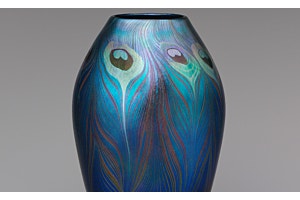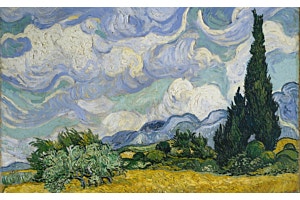
Medieval art history has long emphasized the glories of the Byzantine empire (ca. 330–1453), established when Constantine the Great—the first Christian ruler of the Roman empire—moved the imperial capital east from Rome to the ancient port city of Byzantion in what's now the nation of Turkey. The emperor famously renamed Byzantion Constantinople (“the city of Constantine'') in his own honor, and the Christian state ruled from that city would become known as as Byzantium.


Fabulous feats of art, architecture, and design were crafted during the days of the legendary empire that radiated out of Constantinople. But less known are the profound artistic contributions of North Africa, Egypt, Nubia, Ethiopia, and other powerful African kingdoms, whose interactions with Byzantium had a lasting impact on the Mediterranean world.
On view at The Met Fifth Avenue through March 3, 2024, Africa & Byzantium sheds new light on the staggering artistic achievements of medieval Africa through a range of artworks, including mosaic, sculpture, pottery, metalwork, luxury objects, paintings, and religious manuscripts.


Below, shop items inspired by splendors from the Byzantine world and beyond.
Africa and Byzantium
By Andrea Myers Achi, Mary and Michael Jaharis Associate Curator of Byzantine Art, Department of Medieval Art and The Cloisters, The Metropolitan Museum of Art, New York.


Bringing together more than 170 masterworks in a range of media and techniques, Africa and Byzantium recounts Africa's centrality in transcontinental networks of trade and cultural exchange. With incisive scholarship and new photography of works rarely or never before seen in public, this long-overdue publication illuminates the astounding creations of late antique Africa. It reconsiders the continent's contributions to the development of the premodern world and offers a more complete history of Africa as a vibrant, multiethnic society of diverse languages and faiths that played a crucial role in the artistic, economic, and cultural life of Byzantium and beyond.


Coptic Horsemen Silk Neckerchief
The striking pattern decorating this silk neckerchief evokes a 5th-century fragment of a curtain panel in The Met's Islamic art collection.


Attributed to Egypt, the Museum's Coptic (Christian Egyptian) treasure unites various cultural motifs: wide-eyed hunters on horseback beneath Roman arcades suggest wealth, power, and well-being; baskets heaped with fruits and flowers (symbols of prosperity) are notably similar to those painted on the walls of Umayyad desert palaces in Syria; and roundels contain images of Christian angels. Such early Coptic textiles survive thanks to the dry climate in which they were made and the enduring practice of burying the dead in garments sometimes shrouded in large cloth wrappings.


Byzantine Openwork Statement Jewelry
This sumptuous statement jewelry reimagines an opulent Byzantine bracelet (500–700) in The Met’s medieval art collection.


One of a pair, the Museum’s intricate adornment was probably made in Constantinople and bears lavish ornamentation reflective of the Byzantine taste for color and detail.


The original bracelet’s interior features exquisite opus interrasile craftsmanship—a pierced metalwork technique used by goldsmiths between the 3rd and 7th centuries—while the exterior showcases lustrous stones and pearls. Pearls were especially prized for their luminous beauty in the Byzantine world. As such, our designs are elevated with cultured freshwater pearls.


Coptic Chandelier Earrings
Make a statement with these artful chandelier earrings inspired by a single earring (2nd–3rd century) from Byzantine Egypt in The Met's medieval art collection.


The original was crafted in the Kharga Oasis by a Coptic artisan. Our interpretation borrows its pearl accents and reimagines its semiprecious stone embellishments with aqua jade.


Medieval Byzantine Jewelry
Make a statement with this eye-catching collection inspired by a reconstructed Byzantine adornment featuring beads that likely date to the 10th century in The Met collection.


Our interpretation pays tribute to the original with its hand enameled and semiprecious stone elements.


Shop exhibition-inspired items and more at The Met's Fifth Avenue store and store.metmuseum.org.




